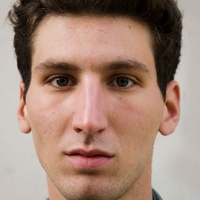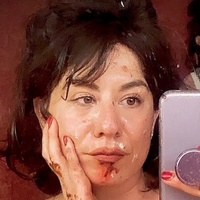On being addicted to your work
Prelude
Lucy Bull is an artist living and working in Los Angeles. She has been the subject of solo exhibitions at David Kordansky Gallery (2022 and 2021); High Art (Arles, 2020; Paris, 2019); Human Resources, Los Angeles (2019); Smart Objects, Los Angeles (2019); and RMS Queen Mary, Mother Culture, Long Beach, California (2017). Her work is in the permanent collections of MAMCO Geneva; Museum of Contemporary Art, Los Angeles; Rose Art Museum, Brandeis University, Waltham, Massachusetts; Museum of Contemporary Art San Diego; Dallas Museum of Art; and Institute of Contemporary Art, Miami. She runs a table-top exhibition space in her apartment called From the Desk of Lucy Bull.
Conversation
On being addicted to your work
Painter and curator Lucy Bull discusses the value of going to the movies, finding stress productive, and channeling the subconscious.
As told to Claudia Ross, 2507 words.
Tags: Art, Curation, Education, Process, Beginnings, Focus, Inspiration.
How do you feel your work changed in a school environment? How did it change after you graduated?
I think it took a while to figure out what I wanted to make and what was actually exciting to me. Things started to click when I was in LA. I definitely don’t think I was making what I needed to make for myself when I was in school. I think that part of being in school is being in a bubble, where you’re too aware of your audience. It wasn’t until maybe five years after school that I started making work that was really the work that I wanted to see, that really felt good to me. And naturally that’s when people started responding to it.
I don’t think it’s good to be too aware of your audience—it’s limiting to know what everyone’s taste is and what they’re drawn to. I was also so aware of the fact that I would have to stand in front of the work, and explain it, and then explaining your work is what kills it. I mean, it’s called a visual language for a reason.
So in school I started making work that explained itself in a very metaphorical way. I made these self-destructing, rotating ornament sculptures, and these weird light box paintings. It’s funny because that is sort of a part of my practice now. I occasionally make lightbox paintings.
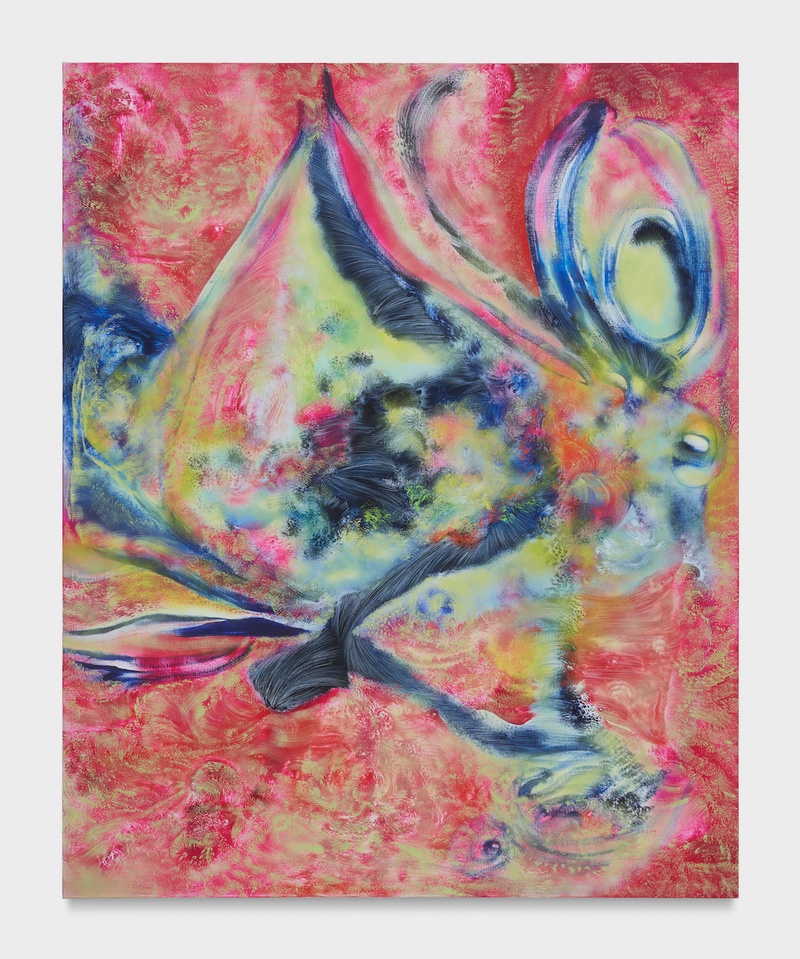
Criss, 2022, oil on linen, 84 x 68 x 1 1/8 inches (213.4 x 172.7 x 2.9 cm), Photo: Elon Schoenholz, Copyright The Artist (Courtesy of David Kordansky Gallery)
I was going to ask you if you thought about working in a different medium. It sounds like that is something you’re experimenting with.
I like different formats, but I do feel like it’s always painting. Even when I was in college, I dabbled in making videos, but they were always from a very painterly approach. They had a painterly kind of tactility, and they were very abstract. I think my approach is just always as a painter.
In writing about your work, critics often relate your painting to cinema. How do you feel about that comparison?
Film is probably what inspires me most. It’s my biggest hobby. It’s also my favorite thinking space. I love going to the movies and being in a crowd of strangers with the lights out, surrounded by color. Afterwards, I always have so many ideas- usually intangible sensations that I want to explore. The mere attempt to translate those fleeting sensations can be a starting point for me.
What films have you thought most about recently?
I recently saw Arnaud Desplechin’s My Sex Life… Or How I Got Into an Argument, but that one’s a more unusual one for me, because it’s so dialogue heavy. And then the most recent transcendental moviegoing experience I have had was seeing Zulueta’s Arrebato (Rapture). My boyfriend and I saw it in 35mm at New Bev, one of my favorite theaters. Afterwards we were both completely floored. [We were] almost shaking. I felt like the movie turned in on itself and I became one of the characters—it became my rapture. It’s very meta. It’s one of those movies that I don’t think I’ll ever watch again, because the experience was so perfect that I need to preserve it.
When you’re painting, what are the feelings that are most important to you, or most interesting to you?
It’s more about channeling the ambiguous or the unknown. Whenever I try to put it into words what each painting is and what I see in them, it’s never exactly right. It’s most exciting when they stir a multitude of associations. Trying to explain them feels limiting.
Some of my paintings have a quieter, slower sort of peacefulness, and others have more violent chaos to them. And both are interesting to me. I like having a variety. It’s all very intuitive.
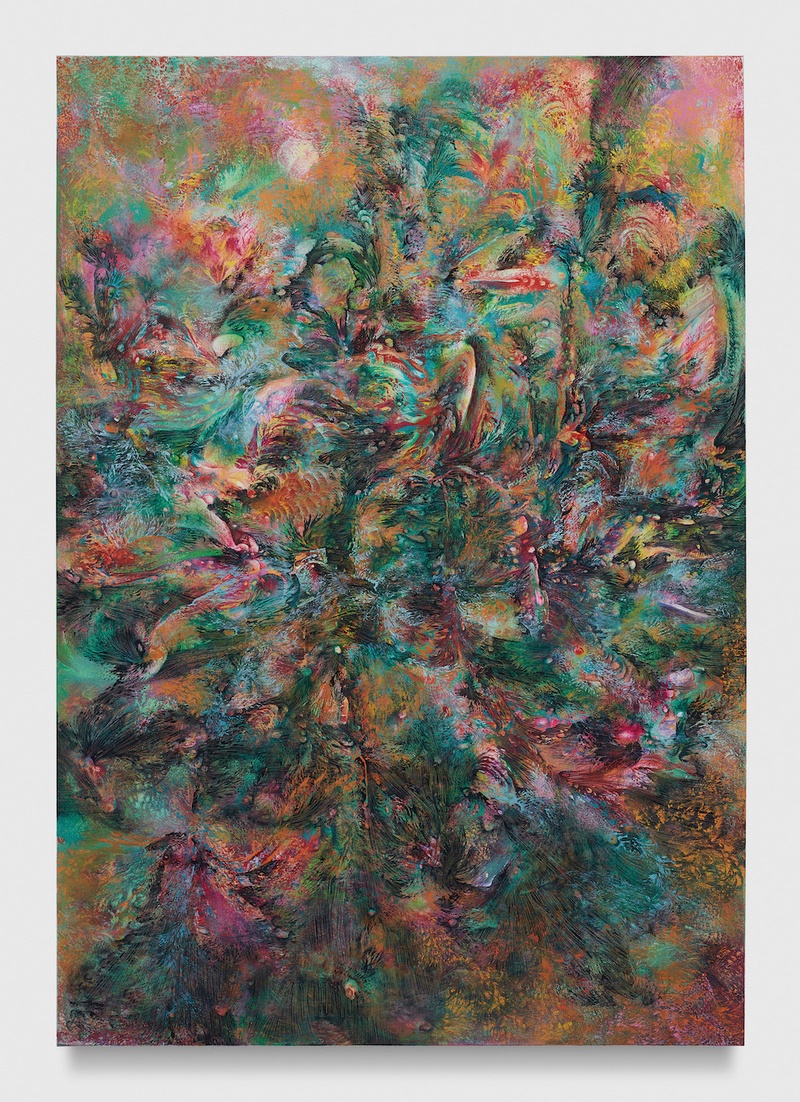
17:31, 2022, oil on linen, 69 1/8 x 48 1/8 x 1 1/8 inches (175.6 x 122.2 x 2.9 cm), Photo: Elon Schoenholz, Copyright The Artist (Courtesy of David Kordansky Gallery)
Do you feel like there’s a correlation between your inner life and what you’re painting? Or does it feel separate, more unknown to you?
Well, when I’m making them, there’s this dance between subconscious, intuitive, spontaneous mark-making, and then more reflective, meditative honing in, a pulling out of different sensations or associations.
And then eventually my taste ends up being what affects my judgment of when it is the right time to finish. There’s always this sense of, “Oh, I could push it forever, but it’ll just be something different.” I usually like to stop right at the moment that everything opens up.
Do you ever abandon work? How do you decide that something isn’t working?
No. I always just continue to work on it. But, actually, that’s how I arrived at the vocabulary of mark-making that I have. At one point, it was a much more shallow network of marks, rather than being so layered. I was working on this book for Onestar Press, and it was all black and white. That’s their format. I started doing more paintings in monochrome, and it really pushed the range of marks that I could use.
When I started introducing color back in, more depth opened up. It just got so much more compelling and so then I started layering on top of older paintings, or paintings that I’d already been working on at the time. The paintings started to have a more interwoven landscape of marks.
There was just a lot of experimentation that led to where I’m at now.
What signals the start of a painting? Are there initial images that you begin with?
No, never. Sometimes, there could be a lighting scenario that I recall, or certain colors I want to use, but then I quickly abandon that. Usually I just start painting.
So there’s a physical relationship to the work, and then it goes outward from there.
It is more process-oriented than people think. I just throw myself into it. In some paintings, the start is really important. Certain layers might get buried, but they always inform what comes next. Sometimes it can be frustrating in the beginning, but eventually something happens.
How do you deal with that frustration, even on a practical level?
I like to have a lot of paintings kicking at the same time. Usually I’ll have three or more paintings going. It’s easy to get tunnel vision if I’m only working on one or two. I feel like I get trapped in looking at it in a very specific kind of way. And sometimes I’ll go in that direction for too long, and look back at different photos that I took throughout the process, and be like, “God damn it. I really had something there.” And so, if I have more than one painting going, I’ll be able to reset my eyes a bit more. I’ll only work on one each day usually, or flip between two. And I like to work long stretches of time.
But it helps to have a break between encounters. Depending on your mood, you’ll look at a painting completely differently.
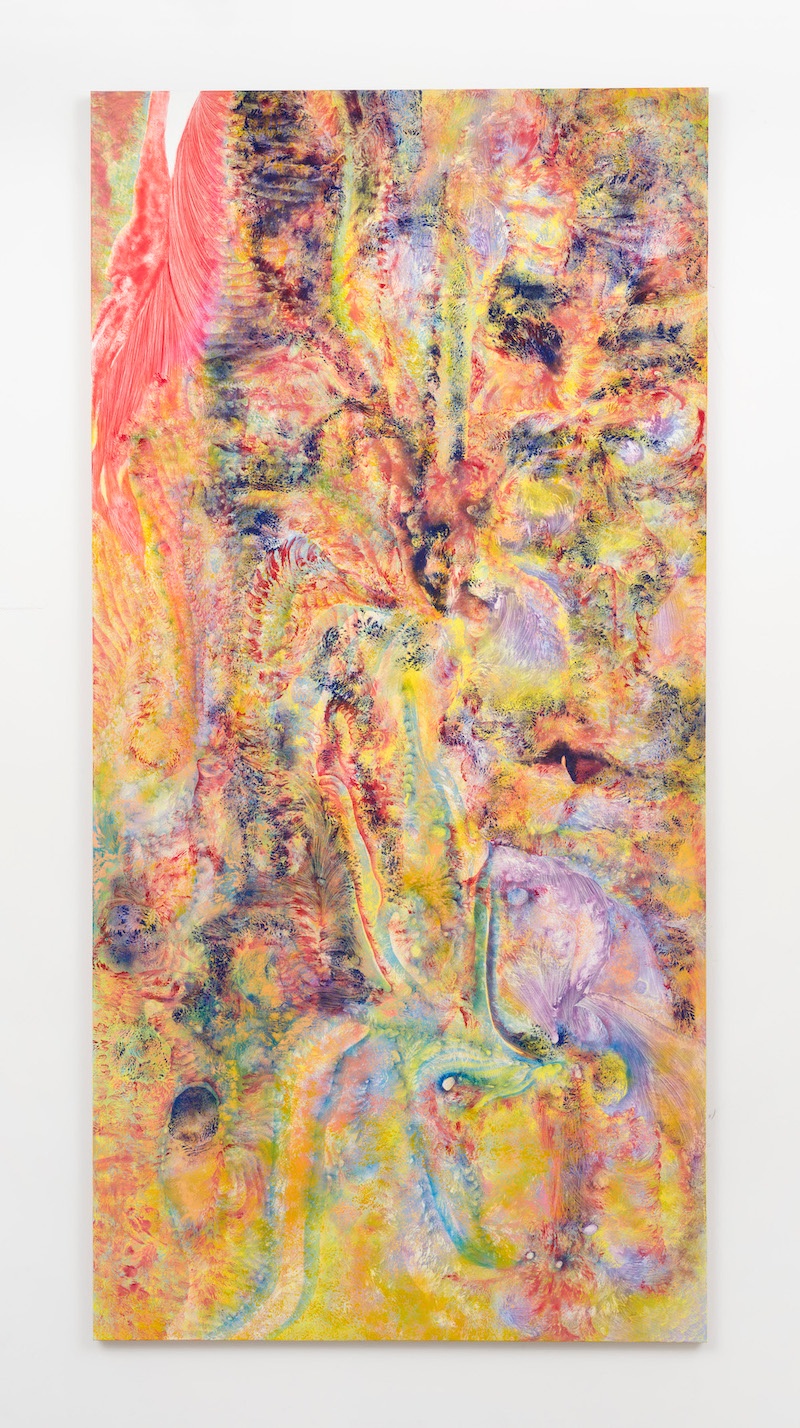
22:52, 2022, oil on linen, 130 x 64 x 1 5/8 inches (330.2 x 162.6 x 4.1 cm), Copyright The Artist (Courtesy of the Artist and David Kordansky Gallery)
What’s your daily schedule?
For the last four months I had a really rigorous painting schedule. Every day I’d try to wake up, work out, and then have coffee, and then go, and just start painting. And then after that I’ll go to the movies. That’s my favorite kind of break. Or get dinner with someone or just work late into the night. Sometimes the hours get weird, but I do like working really late at night, when no one’s going to bother me.
Do you have a separate studio?
Yes. But I’m soon going to live and work in the same place, which I’m really excited to do, because it’s worked for me in the past. I end up living at my studio anyway, and I’d rather have everything combined. Like during the beginning of COVID, I worked in the alley of my apartment. I liked that a lot.
How do you handle a deadline when it is approaching?
I think that the key is just having a regular routine. And I think it’s really important to be able to take breaks. I like to have at least a day off a week, and I like to go to the beach. Everything feels better when you come back after that day.
Have you ever tried other schedules that didn’t work for you?
I mean, I do find it hard to work when I’m traveling. I don’t know. I’m addicted to painting, and if I take too much time away, I feel guilty. I try to sleep as much as I can, and then get there as soon as I can. It’s important to maintain momentum.
Speaking of sleeping—your works feel very dreamlike to me. Is there a connection between your dreams and what you paint?
I don’t really remember my dreams all that well, and I know that I could try out that notebook method, and train myself to remember more. But, yeah, you could say my paintings function like dreamscapes. And the way that I relate and respond to the paintings is similar to dreaming…The human brain always wants to find the face, or make sense of the chaos. Things will appear in your dreams, related to your everyday life, but they surface in weird ways-your dreams are an abstraction. I do feel like there is a subconscious element to the work.
Do you feel like there are times in your life where it’s harder to access the subconscious side?
I think that I am almost too abstract sometimes in the way that I respond to things. And it’s funny, when you’re painting, it’s almost like you’re turning off part of your brain. And so, sometimes it’s hard to switch gears, but that’s because I feel like I’m so trained to access a certain kind of spontaneity and impulse.
It’s interesting because even though your relationship to your own work is very intuitive, you’ve also done these other curatorial projects, which would seem to require a different kind of mental space.
But I have more of an intuitive curatorial process as well. [I work with] certain artists that I have an affinity towards, and who probably work in a similar way. A lot of them have an automatic process.

21:13, 2022, oil on linen, 112 1/4 x 51 x 1 5/8 inches (285.1 x 129.5 x 4.1 cm), Copyright The Artist (Courtesy of the Artist and David Kordansky Gallery)
How do you choose where to stage your curatorial work? Your shows are always really inventively situated. The Desk project, for example.
From the Desk of Lucy Bull started as a venue because I hurt my hand. I couldn’t paint that week so I figured I could finally start working on a program of sorts. I really wanted to create a more intimate environment for viewing art. And so, for a while, I’d been thinking about doing something in my apartment. At the time, I was in East Hollywood, and it was a small studio, and I had very little furniture, because I was using it as both a painting studio and a bedroom.
And I stripped it down, and made it as much of a clean, white cube as possible. I had old paintings stored in the stairwell going up, and in the kitchen. For the openings, I would move my current works in progress into the kitchen. It was ridiculous, honestly. I can’t even believe I did this. And I had this repurposed door that had a metal coating. I found it in Venice. I eventually made it into this low coffee table, and it was the only table that I had. And so, it was my “desk.” I was thinking about how diners would display ephemera or menus under the glass of tables. It felt like the obvious location for bringing people together.
It had a built-in intimacy, which I liked.
What about the car project, Crash?
That was really fun.
I wanted to do something with my friend Alex Metcalf, and she had been reaching out to me, and I was sort of in the midst of a lot of painting, and working on an upcoming show. But I just finally saw a window, and Frieze was happening in LA, so the timing couldn’t have been better.
And she made this amazing chandelier, and her boyfriend helped us figure out how to mount it in the car without drilling through the top. I think I had six stops on the first day, so it was stressful moving around, but it was really cool. Like a traveling living room. I highlighted certain galleries of the LA scene. It was another intimate environment where you could just spend some time around the art. The car is strangely domestic.
I like your focus on community. Do you have people that you talk with about your art practice, or do you keep it private?
I really love talking to my friends who are not artists, or not painters. For the most part I think that it’s more interesting to talk about art with non-artists, because they’ll be a lot more candid about how they’re relating and responding…less shop talk.
Do you have bad habits?
I’ve quit smoking, thankfully. I’m trying to think about what it would be in terms of art-making. I think it’s important to switch things up and avoid getting too comfortable with working in any specific sort of way.
Maybe my bad habit would be not taking enough breaks. Not getting enough fresh air.
I think it’s easy to get stressed and lose sight of how you’re actually doing your work. My dream, basically, is painting. My dream has always been to be a painter. Sometimes I have to remind myself, “Have fun,” and not to stress out.
I’ve learned to fight against the stress. In a way, the pressure is good, and always productive, but sometimes I can get carried away with the productivity side of it.
- Name
- Lucy Bull
- Vocation
- painter, curator
Some Things
Pagination
